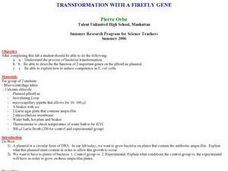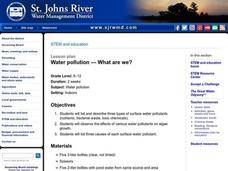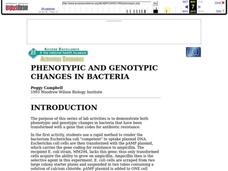NOAA
Watch the Screen!
Can a sponge cure cancer? Life science pupils visit the drugstore under the sea in the fifth activity of six. Working groups research the topic then get hands-on experience by testing the inhibiting effects of several plant extracts on...
Curated OER
On the Microbe Trail: An Introduction to Bacteria and Aseptic Technique
Tenth graders predict the conditions necessary for bacterial growth, test their predictions and at the same time practice the aseptic techniques and safety procedures needed when working with bacteria.
Curated OER
Two Kingdoms of Bacteria
In this bacterial growth worksheet, students conduct an experiment on how temperature affects bacterial growth between a jar placed in the refrigerator and another in a warm place. They also describe what they would infer was the primary...
National Nanotechnology Infrastructure Network
Creating and Testing Silver-Nanoparticle Socks
Antibacterial socks are a product of nanotechnology. An inquiry-based instructional activity asks collaborative groups to create their own antibacterial socks and then test them against other products on the market. The sock with the...
Curated OER
Viruses and Bacteria
In this viruses and bacteria worksheet, learners will read information comparing the characteristics of bacteria and viruses. Then students will match 8 statements as either describing a virus or a bacteria.
Curated OER
Is There Life Before 121?
Students observe microbial growth in the lab. For this biology lesson, students determine the conditions suitable for bacterial growth. They explain the methods of sterilization and bioburden testing.
Curated OER
Antibiotic Resistance
Students conduct an experiment to examine the effects of six different antibiotics on two different types of bacteria. They monitor Petri dishes with bacterial cultures and antibiotic soaked disks. They relate the bacteria growth...
Nuffield Foundation
Maintaining and Preparing Cultures of Bacteria and Yeasts
Don't let your bacteria go to waste. A tutorial explains how to properly store and maintain bacterial stock cultures. It describes the purpose and preparation of a permanent stock, as well as a working stock for use in experiments.
Curated OER
Two Kingdoms of Bacteria
In this bacterial growth learning exercise, 9th graders name and describe the three types of bacteria found. Then they label the figure of the bacterium by writing the correct term next to each number. Students also describe the...
Curated OER
The Meaning of Exponents
In this algebra worksheet, students calculate problems dealing with exponents as it relates to money and savings, bacterial growth and paper folding. There are 3 different sections with questions.
Curated OER
Multiplying Microbes
Ninth graders investigate the techniques of culturing bacteria. They culture bacteria using agar plates. Students identify and describe some environmental conditions that effect bacteria growth.
Curated OER
Bacterial Transformation
Students explore DNA recombination. In this biology lesson, students observe the growth of microscopic species. They predict the phenotype of the transformed colonies.
Curated OER
Viruses and Bacteria
A series of questions about archaebacteria and eubacteria reinforce a chapter on viruses and bacteria. This worksheet is from chapter 18 of an unspecified textbook, but could work with your biology lecture as well. High schoolers...
Curated OER
Superbugs: An Evolving Concern
Students investigate the growth of bacteria in the presence of antibiotics. They write a hypothesis, conduct an experiment to test their hypothesis, analyze the results of their bacterial growth experiment, and describe the results on a...
Curated OER
How Can You Prevent Spoilage?
Middle schoolers complete laboratory activity to discover what temperature is most effective in prohibiting bacterial growth in two percent milk. Students then write lab report detailing findings.
Curated OER
Transformation With A Firefly Gene
Students understand the process of bacterial transformation through experimentation. They describe the function of two important genes of the pBestLuc plasmid. They explain how to induce competence in E. coli cells.
Curated OER
What Are We?
Students list and describe three types of surface water pollutants. They observe the effects of various water pollutants on algae growth. Three causes of each surface water pollutant is listed.
Curated OER
AP Biology Daily Lesson Plans Curriculum
Searching for exciting lesson plans filled with hands-on activities to use in your traditional classroom environment? Look no further! This set of lesson plans for AP Biology covers topics from genetics to evolution, botany to ecology,...
Curated OER
Determining the Effectiveness of Handwashing
Students participate in an experiment in which they grow bacterial colonies. They examine the effects of antibiotics killing the germs. They discuss their findings to end the lesson.
Curated OER
PHENOTYPIC AND GENOTYPIC CHANGES IN BACTERIA
Students use a rapid method to render the bacterium Escherichia coli "competent" in order to uptake plasmid DNA. They also have growth on the plain LB plates by the untransformed cells (which serve as controls). Students perform a cell...
Curated OER
Simulation of Gene Splicing
Students use the exercise as a prelude to a "wet" lab or as a substitute for such a lab. It correlates well with colony transformation labs. This lab is recommended for students what have difficulty with the abstractions that genetic...
Curated OER
Simulation of Gene Splicing
Students simulate gene splicing by examining bacteria. They create a bacterial DNA into which they insert the human DNA (gene) that codes for growth hormone. They cut the sites of the enzyme to study how the human DNA can be joined to...
Curated OER
Some Like It Hot, Some Like It Cold
Students are explained that thermophiles are organisms that have optimal growth temperatures above 50oC. They investigate the temperature ranges for the growth of common bacteria. Students answer the question of do either of these...
Curated OER
An Investigation into Effects of Rhizobium Soil Bacteria on Nitrogen Availability
Learners identify the control and the variables in the experiment. They describe the growth of plants with and without nitrogen fixing bacteria, then name the bacterium responsible for making nitrogen available to the plant.
Other popular searches
- Bacterial Growth Curves
- Bacterial Growth Inhibition
- Bacterial Growth Prevention
- Bacterial Growth 22
- Bacterial Growth 2.2

























